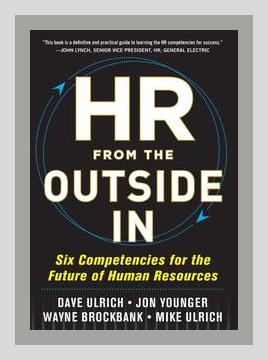Human Resources and Talent ManagementHR Technology
of “HR from the Outside In: Six Competencies for the Future of Human Resources” by Dave Ulrich, Max and Mark Nyman, and Jon Younger.
Introduction
“HR from the Outside In: Six Competencies for the Future of Human Resources” emphasizes the evolving role of HR professionals who must look beyond traditional functions to add value to their organizations. The book argues that HR must be aligned with external business realities and delivers a framework comprising six key competencies that HR professionals should develop.
Six Competencies for the Future of Human Resources
1. Strategic Positioner
- Overview: This competency focuses on the role of HR in aligning strategies with the external environment. Strategic positioners should understand market trends, global business issues, and how these factors impact the organization.
- Examples:
- An HR professional working in a technology firm conducting regular market analysis to identify emerging tech trends.
- Building partnerships with top academic institutions to stay abreast of cutting-edge research.
- Action: Engage in ongoing education and collaboration with external consultants to keep updated on market conditions and leverage this knowledge to influence organizational strategy.
2. Credible Activist
- Overview: HR professionals must be credible to their peers and stakeholders and be activists who offer innovative solutions and champion employee issues.
- Examples:
- Implementing transparent communication strategies to build trust within the organization.
- Using data-driven insights to advocate for necessary changes in organizational policies.
- Action: Develop a reputation for reliability by consistently delivering on promises, and provide actionable recommendations based on thorough research and employee feedback.
3. Capability Builder
- Overview: HR must identify, develop, and sustain organizational capabilities such as talent management, culture, and operational efficiency.
- Examples:
- Designing leadership programs to cultivate future leaders.
- Creating a culture of continuous learning with advanced training modules.
- Action: Conduct a capability audit to identify strengths and weaknesses in the organization and use the findings to develop targeted programs that address gaps.
4. Change Champion
- Overview: HR professionals need to be adept at driving and managing change within the organization. They should facilitate transitions and support employees throughout the process.
- Examples:
- Leading digital transformation projects by introducing new HR technologies such as automated performance management systems.
- Implementing a structured change management framework like ADKAR (Awareness, Desire, Knowledge, Ability, Reinforcement).
- Action: Develop a structured change management plan that includes stakeholder analysis, communication strategies, and training programs to support smooth transitions.
5. HR Innovator and Integrator
- Overview: This competency involves designing and implementing integrated HR practices that drive business performance.
- Examples:
- Using people analytics to inform decisions on recruitment, retention, and succession planning.
- Implementing integrated HRIS (Human Resource Information Systems) that streamline HR processes.
- Action: Set up cross-functional teams that include IT and analytics experts to review existing HR systems and propose integrated solutions that enhance efficiency and data accuracy.
6. Technology Proponent
- Overview: HR professionals should leverage technology to improve HR practices and the overall employee experience.
- Examples:
- Introducing AI-driven recruitment platforms to streamline candidate sourcing and selection processes.
- Employing Employee Self-Service (ESS) portals to enhance employee autonomy and reduce administrative burden.
- Action: Conduct a technology audit to assess current HR systems and identify opportunities for upgrading to new technologies that offer better functionality and user experience.
Conclusion
“HR from the Outside In” presents a compelling framework for modern HR professionals who aim to stay competitive and add value in a rapidly changing business environment. By developing these six competencies, HR can transcend traditional roles and act as strategic partners in achieving organizational success.
Concrete Examples and Specific Actions
Strategic Positioner
- Example: An HR professional engages in bi-annual market analysis to identify industry shifts.
- Action: Schedule regular workshops with external market analysts to discuss findings and implications for the company’s strategic plans.
Credible Activist
- Example: Implement data-driven diversity initiatives based on employee feedback.
- Action: Develop a quarterly report on diversity metrics and share it with senior management to underline the importance of continual improvement.
Capability Builder
- Example: Rolling out a leadership development program that includes mentoring, coaching, and rotational assignments.
- Action: Create a competency framework that identifies and addresses the skills necessary for future leaders, and align the program with these competencies.
Change Champion
- Example: Introducing an enterprise-wide ERP system and leading the transition.
- Action: Conduct training sessions and regular check-ins with employees to ensure a smooth adoption of the new system.
HR Innovator and Integrator
- Example: Integrating performance management systems with learning and development platforms.
- Action: Develop a project plan with IT to ensure seamless integration and train HR staff and employees on the new functionalities.
Technology Proponent
- Example: Deploying a chatbot for answering routine HR queries.
- Action: Collaborate with IT to design and roll out the chatbot, then measure its effectiveness through user feedback and improvement iterations.
Final Thoughts
Implementing the competencies proposed in “HR from the Outside In” provides a clear pathway for HR professionals to transform from operational experts to strategic business partners. Adopting these practices will not only enhance their own roles but significantly contribute to their organizations’ success in navigating a complex and ever-changing business environment. By continuously improving these competencies, HR professionals can ensure that they remain relevant and valuable in the future world of work.
